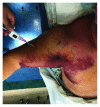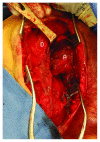Compartment Syndrome of the Flexor Compartment of the Arm Secondary to Pectoralis Major Tendon Rupture
- PMID: 30652040
- PMCID: PMC6311819
- DOI: 10.1155/2018/9042820
Compartment Syndrome of the Flexor Compartment of the Arm Secondary to Pectoralis Major Tendon Rupture
Abstract
Case. Compartment syndrome following muscle rupture is a rare entity with few mentions in the literature. We present a case of pectoralis major rupture in a 38-year-old male that evolved into compartment syndrome of the anterior compartment of the arm. Rupture of the pectoralis is uncommon and most often occurs during weight lifting. Compartment syndrome secondary to this injury is extremely uncommon, with only one reported case in the pectoralis major itself and several cases of biceps compartment syndrome. Due to the potentially devastating consequences of a missed compartment syndrome, it is imperative that physicians maintain a high level of suspicion in patients with these unusual injuries presenting with severe swelling and pain.
Figures








Similar articles
-
Distal biceps brachii tendon rupture resulting in acute compartment syndrome.Orthopedics. 2013 Nov;36(11):e1479-81. doi: 10.3928/01477447-20131021-38. Orthopedics. 2013. PMID: 24200459
-
Rare case of upper arm compartment syndrome following biceps tendon rupture.Orthopedics. 2008 May;31(5):494. doi: 10.3928/01477447-20080501-09. Orthopedics. 2008. PMID: 19292309
-
Acute compartment syndrome following distal biceps tendon rupture in an otherwise healthy male.Am J Orthop (Belle Mead NJ). 2013 Nov;42(11):519-20. Am J Orthop (Belle Mead NJ). 2013. PMID: 24340323 Review.
-
Complete Pectoralis Major Tendon Rupture With Bony Avulsion in an Adolescent Male: A Case Report and Literature Review.Cureus. 2024 Jan 3;16(1):e51616. doi: 10.7759/cureus.51616. eCollection 2024 Jan. Cureus. 2024. PMID: 38313965 Free PMC article.
-
Rupture of the pectoralis major: a case report and review.J Emerg Med. 2010 Feb;38(2):196-200. doi: 10.1016/j.jemermed.2008.01.025. Epub 2008 Sep 25. J Emerg Med. 2010. PMID: 18818044 Review.
References
Publication types
LinkOut - more resources
Full Text Sources
Molecular Biology Databases

